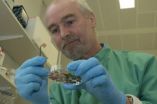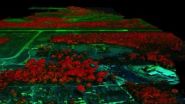(Press-News.org) Fertility tests frequently reveal that males have problems with the quality of their sperm. The problems often relate to sperm senescence, which is a reduction in quality with age. Sperm senescence can arise either before or after the DNA in the sperm cells is produced by a process known as meiosis. So-called "pre-meiotic" senescence results from accumulated damage in the germline cells with increasing age and results in older males having sperm of lower quality. Post-meiotic senescence occurs after the sperm cells have been produced, either during storage of sperm by the male or after ejaculation and before they fertilize the eggs.
There is previous evidence that various kinds of sperm senescence occur in insects, in some domestic animals (birds and mammals) and even in humans but the studies have generally been carried out under fairly artificial conditions and so it is not clear how they relate to wild animals – or to the general human population. These objections have been overcome in the latest work of Attila Hettyey and colleagues at the Konrad Lorenz Institute of Ethology, University of Veterinary Medicine, Vienna (Vetmeduni), together with Balázs Vági in Budapest, Hungary, where Hettyey himself is now working.
The researchers investigated the common toad, an interesting model system as it is known to produce all its sperm before the start of the breeding season. They found that male toads that re-entered hibernation at the start of the breeding season, i.e. that lowered their metabolic rates after producing sperm, stored sperm of significantly higher motility than males kept under pseudo-natural conditions without females throughout the entire breeding season. The result means that slowing the normal rate of general physiological processes reduced the normal rate of sperm ageing within the toad's testicles. This constitutes the first evidence for post-meiotic intra-testicular sperm senescence in a wild vertebrate. A further surprising result was that in males kept under pseudo-natural conditions, sperm motility was related to the number of matings a male achieved, with the presence of females or the occurrence of matings having a positive effect on the quality of stored sperm. This suggests that post-meiotic intra-testicular sperm senescence does not occur at a fixed rate but may be modulated by external factors, such as temperature and number of matings.
In summary, the scientists at the Vetmeduni have shown that sperm senescence occurs while sperm are stored in the testicles of animals living under essentially "natural" conditions. They also suggest that the rate of sperm senescence can be slowed if males mate more frequently. For animals that produce sperm continuously, such as man, the implications seem to be that more frequent ejaculations serve both to remove older and thus less viable sperm as well as to reduce the damage to sperm cells during storage. The senior author on the PlosONE paper, Richard Wagner, is keen to speculate on the importance of the results. "We do not yet know how general post-meiotic sperm senescence is in wild animals, or man. But if it turns out to be widespread, it will be fascinating to see how it affects reproductive behaviour." As Hettyey says, "Females may try to avoid males with damaged sperm while males may choose particular environments that slow sperm senescence and may attempt to shorten periods of sexual rest by also accepting matings with low-quality females or by discharging aged sperm."
###The paper "Post-meiotic intra-testicular sperm senescence in a wild vertebrate" by Attila Hettyey, Balázs Vági, Dustin J Penn, Herbert Hoi and Richard H. Wagner has just been published in the online journal "PlosONE" (doi:10.1371/journal.pone.0050820).
The scientific article in full text online (Open Access):
http://www.plosone.org/article/info%3Adoi%2F10.1371%2Fjournal.pone.0050820
About the Vienna University of Veterinary Medicine
The University of Veterinary Medicine, Vienna is the only academic and research institution in Austria that focuses on the veterinary sciences. About 1000 employees and 2300 students work on the campus in the north of Vienna, which also houses the animal hospital and various spin-off-companies.
http://www.vetmeduni.ac.at
Scientific contacts:
Dr. Richard Wagner
Konrad Lorenz Institute of Ethology
University of Veterinary Medicine, Vienna
T +43 1 48909-15831
Richard.Wagner@vetmeduni.ac.at
Dr. Attila Hettyey
Behavioural Ecology Group
Eötvös Loránd University, Budapest (HU)
T +36 1 3918652
hettyey.attila@agrar.mta.hu
Distributed by:
Klaus Wassermann
Public Relations/Science Communication
University of Veterinary Medicine, Vienna
T +43 1 25077-1153
klaus.wassermann@vetmeduni.ac.at
Fitness for toad sperm: The secret is to mate frequently
2012-12-04
ELSE PRESS RELEASES FROM THIS DATE:
The dance of quantum tornadoes
2012-12-04
Tornado-like vortexes can be produced in bizarre fluids which are controlled by quantum mechanics, completely unlike normal liquids. New research published today in the journal Nature Communications demonstrates how massed ranks of these quantum twisters line up in rows, and paves the way for engineering quantum circuits and chips measuring motion ultra-precisely.
The destructive power of rampaging tornadoes defeats the human ability to control them. A Cambridge team has managed to create and control hundreds of tiny twisters on a semiconductor chip. By controlling where ...
Moderate coffee consumption may reduce risk of diabetes by up to 25 percent
2012-12-04
Drinking three to four cups of coffee per day may help to prevent type 2 diabetes according to research highlighted in a session report published by the Institute for Scientific Information on Coffee (ISIC), a not-for-profit organisation devoted to the study and disclosure of science related to coffee and health.
Recent scientific evidence has consistently linked regular, moderate coffee consumption with a possible reduced risk of developing type 2 diabetes. An update of this research and key findings presented during a session at the 2012 World Congress on Prevention ...
Fox invasion threatens wave of extinction, UC research finds
2012-12-04
Using DNA detection techniques developed at the University, the team mapped the presence of foxes in Tasmania, predicted their spread and developed a model of their likely distribution as a blueprint for fox eradication, but swift and decisive action is needed.
University of Canberra professor in wildlife genetics and leader of the team, Stephen Sarre, found foxes are widespread in northern and eastern Tasmania and the model developed by his team forecasts they will spread even further with likely devastating consequences for the island's wildlife.
"There's nothing ...
Ray of hope for human Usher syndrome patients
2012-12-04
After years of basic research, scientists at Johannes Gutenberg University Mainz (JGU) are increasingly able to understand the mechanisms underlying the human Usher syndrome and are coming ever closer to finding a successful treatment approach. The scientists in the Usher research group of Professor Dr. Uwe Wolfrum are evaluating two different strategies. These involve either the repair of mutated genes or the deactivation of the genetic defects using agents. Based on results obtained to date, both options seem promising. Usher syndrome is a congenital disorder that causes ...
New study shows how copper restricts the spread of global antibiotic-resistant infections
2012-12-04
New research from the University of Southampton has shown that copper can prevent horizontal transmission of genes, which has contributed to the increasing number of antibiotic-resistant infections worldwide.
Horizontal gene transfer (HGT) in bacteria is largely responsible for the development of antibiotic-resistance, which has led to an increasing number of difficult-to-treat healthcare-associated infections (HCAIs).
The newly-published paper, which appears in the journal mBio, shows that while HGT can take place in the environment, on frequently-touched surfaces, ...
Metabolic biomarkers for preventive molecular medicine
2012-12-04
One of the big challenges of biomedicine is understanding the origin of illnesses in order to improve early detection and significantly increase recovery rates, as well as being able to do what CNIO researchers call preventive molecular medicine, which consists of identifying those individuals who have a greater molecular risk of suffering certain pathologies in order to prevent them. The ageing of the organism, and therefore of the cells and tissues it is made of, represents the greatest risk factor for the majority of developed-world illnesses, including cancer.
A team ...
Carnegie debuts revolutionary biosphere mapping capability at AGU
2012-12-04
San Francisco, CA —Researchers from the Carnegie Institution are rolling out results from the new Airborne Taxonomic Mapping System, or AToMS, for the first time at the American Geophysical Union (AGU) meetings in San Francisco. The groundbreaking technology and its scientific observations are uncovering a previously invisible ecological world. To watch a video about how AToMS is helping researchers look at the world in a whole new way, click here.
AToMS, which launched in June 2011, uniquely combines laser and spectral imaging instrumentation onboard a twin-engine aircraft ...
African savannah -- and its lions -- declining at alarming rates
2012-12-04
DURHAM, NC -- About 75 percent of Africa's savannahs and more than two-thirds of the lion population once estimated to live there have disappeared in the last 50 years, according to a study published this week in the journal Biodiversity and Conservation.
The study, led by Duke University researchers, estimates the number of lions now living on the savannahs to be as low as 32,000, down from nearly 100,000 in 1960. Lion populations in West Africa have experienced the greatest declines.
"The word savannah conjures up visions of vast open plains teeming with wildlife. ...
Driverless vehicles expected to navigate intersection of safety, speed
2012-12-04
How do driverless vehicles navigate through intersections? Faster and safer than if humans were in charge, according to researchers with the Virginia Tech Transportation Institute.
Autonomous vehicles will turn themselves over to an automated intersection controller, which adjusts the trajectory and speed of the vehicles to prevent crashes, said Ismail Zohdy of Cairo, Egypt, a Ph.D. student in civil engineering at Virginia Tech, and Hesham Rakha, director of the Center for Sustainable Mobility at the transportation institute and professor of civil engineering at the university. ...
New method for creating long-lived stem cells used for bone replacement
2012-12-04
New Rochelle, NY, December 4, 2012—Human mesenchymal stem cells (hMSCs) can develop into bone cells and are useful for tissue engineering and regeneration. However, when grown in the laboratory they quickly lose their ability to continue dividing and they die. A method for genetically engineering hMSCs so they become immortal and still retain their ability to become bone cells is described in an article published in BioResearch Open Access, a bimonthly peer-reviewed journal from Mary Ann Liebert, Inc., publishers. The article is available free on the BioResearch Open Access ...


